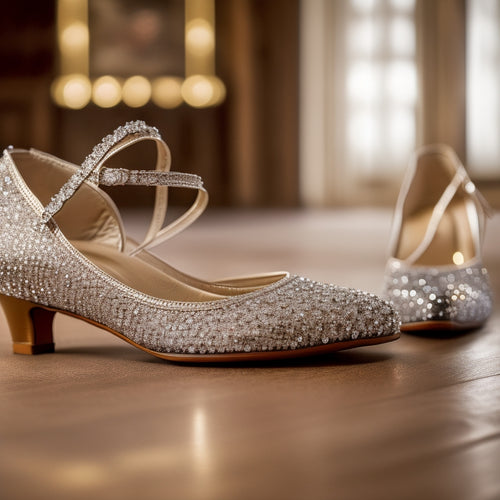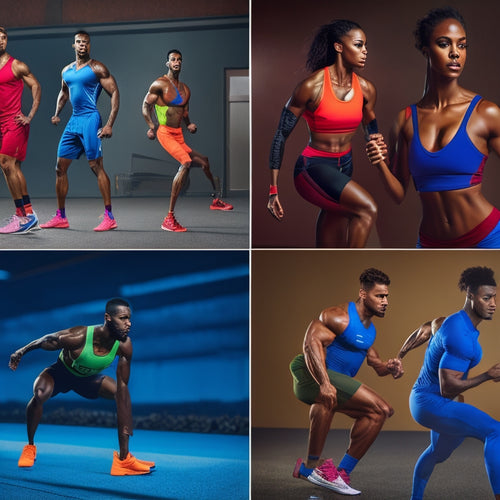
Discover the Dance: Ballroom Basics Unleashed
Share
Discovering the world of ballroom dance begins with mastering the fundamentals. A strong foundation in technique, proper partnering, and a deep understanding of the music that drives the movement is essential. Mastering the ballroom hold is key, enabling a seamless connection with your partner and effortless movement across the dance floor. Next, focus on essential dance steps like the Slow Waltz, Rumba, and Cha Cha, incorporating techniques like smooth gliding and rise and fall. As you progress, you'll uncover advanced techniques and nuances to refine your performance and create a mesmerizing show.
Key Takeaways
• Mastering the ballroom hold is essential for a seamless connection with your partner and effortless movement across the dance floor.
• Start with basic dance styles like Slow Waltz, Rumba, and Cha Cha, which can be danced to popular music.
• Focus on footwork techniques like smooth gliding and rise and fall to improve your overall dance performance.
• Engage your core to strengthen your connection with your partner and achieve a comfortable ballroom hold.
• Practice emphasizing musicality and styling to add flair to your dance moves and captivate your audience.
Mastering the Ballroom Hold
Achieving a comfortable and secure ballroom hold is essential for a strong foundation in ballroom dance. It enables a seamless connection with your partner and allows for effortless movement across the dance floor.
A proper hold begins with correct hand placements. The leader's right hand is placed on the follower's left shoulder blade, and the follower's right hand is placed on the leader's left shoulder. This connection is strengthened by engaging the core, which improves balance and posture.
Essential Dance Steps Uncovered
With a solid foundation in the ballroom hold, dancers can now focus on mastering the essential dance steps that form the backbone of various ballroom styles.
The Slow Waltz, Rumba, and Cha Cha are excellent starting points, as they can be danced to popular music. When learning these steps, focus on footwork techniques such as smooth gliding, rise and fall, and Cuban motion.
Practice tips include emphasizing musicality and styling, using iconic timing, and perfecting the Box Step and Side Basic Step.
As you progress, incorporate lively and fast footwork, triple step chasses, and hip actions.
Exploring Beyond the Basics
Beyond mastering the fundamental steps, dancers can now venture into exploring advanced techniques, nuances, and styling that refine their overall ballroom dance performance. This is where the true artistry of ballroom dance comes alive.
Advanced techniques such as dynamic movements, turns, and dips can elevate your performance, while nuances like musicality insights and partner dynamics can add depth and emotion to your dance. By incorporating these elements, you can create a mesmerizing show that leaves a lasting impression on your audience.
Frequently Asked Questions
What Is the Ideal Dance Shoe for a Beginner?
"When I first stepped onto the dance floor, I felt like a wobbly fawn. But with the right shoes, I found my footing. For beginners, look for dance shoes with Sole Support and a moderate Heel Height (1.5-2 inches) for stability and comfort."
How Do I Overcome Shyness When Dancing in Public?
To overcome shyness when dancing in public, focus on building Confidence Boosting techniques, such as positive self-talk, visualization, and practice, to cultivate Fearless Expression, enabling you to shine on the dance floor with authenticity and grace.
Can I Learn Ballroom Dance if I Have Two Left Feet?
With dedication and practice, anyone can learn ballroom dance, regardless of coordination. Focus on developing muscle memory and body awareness through repetitive exercises, and you'll be gliding across the floor in no time.
What Is the Best Way to Find a Practice Partner?
To find a practice partner, set clear Partner Expectations, and seek like-minded Dance Buddies through local dance studios, online forums, or social media groups, ensuring a harmonious and productive learning experience.
Can I Take Ballroom Dance Lessons if I'm Significantly Overweight?
"Embrace body positivity and self-acceptance! Ballroom dance is for every body, regardless of size. Focus on technique, connection, and musicality, and don't let weight hold you back from experiencing the joy of dance."
Related Posts
-

Why Digital Solutions Are a Game-Changer
By integrating digital solutions into your operations, you can revolutionize your workflows, discover new revenue str...
-

Best Ballroom Dance Shoes for International Style
When you're selecting the best ballroom dance shoes for International Style, focus on essential features like grip, c...
-

Essential Performance Apparel for Every Gym Session
Choosing the right performance apparel is essential for maximizing your gym sessions. Look for moisture-wicking mater...


